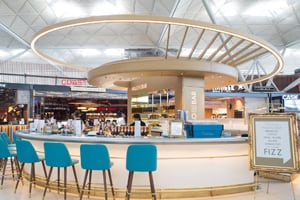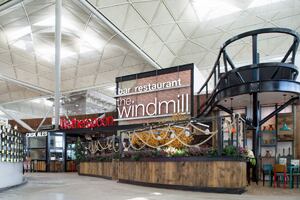Stansted Airport’s recent £80m redevelopment saw over 70 operators bid for just 12 sites, with the final selection including airport firsts, big name brands and a celebrity chef.
Beth Brewster, retail director at Manchester Airport Group (MAG), described the selection process as ‘the best headache of my career’.
She said: “Consumers have got more demanding and it’s important that an airport recognises that and gives people as good an experience, if not better, than they would get on the high street.
“In food and beverage airports can innovate even more than retail. One of the things we challenged all of the partners to do, particularly the more established brands, was to give us something different.”
Starbucks has chosen Stansted to trial its first UK evening menu, while Burger King has debut a custom Coca Cola machine with over 120 flavours - allowing customers to create their own varieties.
Customers become more demanding
Though airside foodservice outlets have to cater to a wide range of passengers, consumer expectations have been raised across the board.

The Stansted development has seen the debut of luxury operator Cabin and the bespoke Halo cocktail bar, designed especially for the airport.
Brewster said: “The shift towards the luxury market is down to people being more demanding in a good way. Casual dining table service concepts like Giraffe have really grown in airports in the last few years. There’s been a rise of the ‘treat me’ mentality, which you can also see in the growth of executive lounges.”
However, she was clear that airports should avoid being ‘snobby’ about branded fast food. In Stansted 40 per cent of passengers passing through the airport are not UK originating, creating the need for larger ‘trusted’ brands to sit alongside lesser known airport firsts.
She said: “It’s a huge part of the market. No two passengers are the same; depending on why you travel you want different things.”
Big name brands Giraffe, Leon, Burger King, Itsu, Pret a Manger, Starbucks and Wetherspoons have all opened bespoke sites at Stansted alongside airside firsts from coffee chain Harris and Hoole, American diner concept Coast to Coast and the first James Martin Kitchen.
Looking ahead
With tenders signed on for long term contracts, airports need to ensure they select brands which will still be relevant several years down the line.
Brewster said consumers were increasingly looking for something ‘a little bit different or a little bit healthier, something that’s not your standard airport fare’.

To meet demand, operators are creating bespoke sites and adapting their menus to meet expectations.
Following a £2.7m redevelopment JD Wetherspoon’s have opened their largest airside outlet to date, The Windmill Pub, which features a rotisserie, flight information boards, a recharging area for mobile phones and a transparent cellar.
By 12pm 50 per cent of passengers have already passed through the airport, so sites such as Cabin are offering a longer breakfast menu to cater for increased demand.
Speed of service is vital, and menus are adapted to ensure quality is not compromised. Wetherspoons, Giraffe and Cabin have also included open kitchens in their new sites to reduce the feeling of diners waiting around for their food.
“Customer expectations are higher and there is tougher competition.” said Dave Wells, commercial manager at The Restaurant Group, which runs Giraffe, Coast to Coast and Halo Bar at Stansted.
“Though ‘premium’ is often associated with ‘slow’, airports won’t start introducing formal dining. We are seeing better quality offerings, and that is going to continue.”
Hotels
The hotel sector is also set to benefit from airport redevelopment, with real estate advisor Savills reporting today (6 May) that the planned expansion of Gatwick or Heathrow airport could see demand for hotel rooms rise by 71 per cent and 42 per cent respectively.
A second runway at Gatwick will require an additional 4,800 rooms and a third runway or extended north runway at Heathrow will see demand for an additional 4,000 rooms, according to the firm.
As passenger numbers continuing to rise, new brands and concepts such as Yotel and Bloc are set to continue changing the airside offering.
Marie Hickey, commercial research director at Savills, said: “Regardless of which option the Airports Commission chooses [for expansion], it will generate demand for new supply. In turn, this will introduce new product types and brands providing greater convenience for travellers.”
